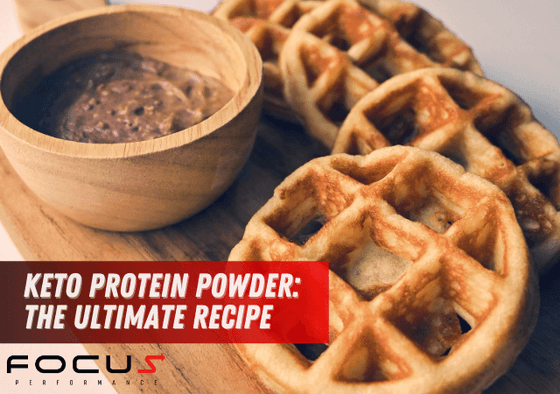
The ketogenic diet has been around since caveman times, when instinctually, the most attractive source of food was high-fat, energy-rich meat. The updated version, a diet which consists of up to 70% fat, is said to accelerate weight loss, stabilise energy levels and help you to preserve valuable muscle.
Can a diet so high in fat – we’re talking eggs and bacon for breakfast, burgers and mayonnaise for lunch and steak and eggs for dinner – really be that good for you? Why might you consider a ketogenic diet? And what should you expect if you start one?
We’ll get into some detail, but in a nutshell, the ketogenic diet is said to:

Ketones are a type of energy produced in the liver. They’re used by the brain and body instead of glucose – the body’s usual preferred source of energy.
Here’s how the process works:
In a moderate or high-carb diet, insulin is released by the pancreas to convert sugar into glucose for energy. If you are eating a diet which is high in carbohydrates your body will have no need to burn your fat stores for energy, meaning you will not lose weight or improve your body composition.
When eating a ketogenic diet much less carbohydrates will be entering the body in the first place, limiting your body’s need to release insulin, which means lower blood sugar levels. In order to maintain an effective energy source for the body, your liver will start to release fatty acids, these fatty acids are then oxidised turning to them into useable energy (blood ketones).
Many bodybuilders and athletes prefer to use a ketogenic diet over a high-carbohydrate diet, in part because with lower insulin levels, more growth hormone is released. This in turn can lead to more muscle growth and faster recovery times between workouts.
You can think of making the transition to a ketogenic diet like changing the fuel tank on your car, and then giving the engine a tune-up. There’s a little bit of work involved to make the switch, but you could end up with something that runs more efficiently.

A ketogenic diet is high in fat (saturated and unsaturated, but not artificial trans fats), moderate protein, and low in carbohydrates.
The idea is that using ketones as energy reduces the body’s reliance on instant, glucose-based energy. Using ketones as an energy source means you will be burning more body fat. Coupled with adequate protein intake, a ketogenic diet can be one of the most effective ways of shedding excess fat, while maintaining or even building muscle.
A standard ketogenic diet looks something like this:
Fats – 70-80%
Protein – 20-30%
Carbohydrates – Maximum of 50g/day
In basic terms, insulin is released by the pancreas, and its job is to convert carbohydrates into glucose. That glucose is transported to cells to be used as energy. Your fat stores are barely touched during this process.
Ketones are released by the liver. Once in the bloodstream, they are converted to fully-fledged blood ketones and transported around the body, where they enable the metabolisation of your fat stores for energy.
When you eat lots of carbohydrates, your blood glucose levels rise and your pancreas is forced to release insulin to deal with it all. If you eat a diet high in simple sugars and carbohydrates for long periods of time eventually your blood sugar (glucose) levels will get so high that insulin either becomes much less effective, or stops working altogether. Type II diabetes is a common result.
Chronically high blood glucose levels and a bloodstream full of ineffective insulin has been shown to lead to low-level systemic inflammation. That’s a disaster for all of your organs and systems.
Beyond weight loss, a ketogenic diet can be effective at lowering blood glucose levels, improving insulin sensitivity and keeping inflammation in check. It should be noted, however, that using the ketogenic diet as a magic bullet, without proper medical advice, isn’t advisable. Always consult a professional.

The KetoDiet App website contains some great resources for kickstarting your ketogenic journey. How much you eat, and how many meals a day you have, depends on your goals.
If you’re simply trying to lose weight, a moderate ketogenic diet can be pretty effective. The reasons are two-fold:
The paleo diet, which excludes grains, dairy and processed foods, is very similar to the ketogenic diet, although the emphasis there is on high-protein foods, while with a ketogenic diet, the emphasis is on dietary fat.
Foods popular on a ketogenic diet include:
The ketogenic diet has its roots in the use of fasting as a treatment for epilepsy. The ancient Greeks would treat all manner of illnesses – including epilepsy – with a change in diet.
During the early 1900s, physical culture proponents like Bernarr MacFadden, capitalised on the idea of fasting for overall health, by establishing popular sanitariums, complete with Turkish baths and gymnasiums. Epilepsy sufferers who visited MacFadden’s sanitarium, or who followed his methods, apparently saw the severity of their seizures reduce dramatically on a fasting diet.
The ketogenic diet is an extension of the fasting diet. They afford many of the same benefits, with the obvious difference being that on a ketogenic diet, you’ll eat a lot more.

In the early stages, some people complain about a lack of energy, thanks to dropping carbohydrates. Distance runners and endurance athletes may notice this more than strength athletes, but it seems as though anyone can be affected.
During the switch to a ketogenic diet, one of the other common complaints is brain fog. Glucose is a fast-acting energy source, and like caffeine, if you’ve been used to feeding it to your body and brain for years, restricting it can have side-effects.
Any side-effects, however, should be temporary, as your body adjusts to its new source of energy.
It takes on average, up to three weeks to fully transition to a state of ketosis (but can happen within a few days if you are very strict), after which time you can look forward to:
Like the paleo diet, a ketogenic diet cuts out almost all grains, which have been linked to inflammation, stiffness and joint pain. A high-grain diet has also been linked to bloating and other digestive problems (like leaky gut and small intestinal bacterial overgrowth), so you could see a reduction here too, which if you’re in training, is a great help.
Eating a ketogenic diet is a very effective way to give yourself a fresh start when it comes to how you look, feel and think. For beginners I would suggest looking into the modified Atkins diet as a template of what to eat and when. This will make the process much less challenging and give you the best chance possible of making the diet work.
“Estimates of the overall efficacy of the KD in controlling seizures were reported as follows: 16% became seizure free, 32% had a >90% reduction in seizures, and 56% had a> 50% reduction. The KD is high in fat, moderate in protein, and low in carbohydrates.”
An Overview of the Ketogenic Diet for Pediatric Epilepsy
“[A ketogenic diet can see an] Increase in HDL Cholesterol (the more saturated fat you eat, the higher it will go.) This is actually a good thing, because it improves the ratio of HDL/LDL. Higher HDL levels (above 39 mg/dL) indicate a healthier heart.”
“When you keep your carbs sufficiently low, your body switches to a fat metabolism; this is called the ‘Metabolic Switch’. Switching from a carbohydrate to a fat metabolism has some real advantages for the bodybuilder:”
After a lifetime of carbohydrates, making the switch to a ketogenic diet can be tricky. You may experience an initial dip in energy levels, and have to contend with brain fog. Stick it out, however, and you could be on your way to rapid weight loss, increases in muscle mass and unshakeable energy levels.
For an in-depth look at the history of the ketogenic diet and fasting, read this article by Robb Wolf.
Have you tried a ketogenic diet? Did you see and feel the kind of results you were expecting?
Despite the benefits we’ve learned about protein powders, not all of them are keto-friendly. Just like any product for people on a low-carb diet, you need to read the label closely to make sure you’re not consuming added carbs and sugars.


Scott Reid
Author
Scott Reid is a 2 x Britain’s Strongest Man U105kg winner (2007 & 2008) and IFSA World's Strongest Man U105kg Competitor. He is an expert in strength and conditioning and also coaches functional nutrition. Scott’s passion for understanding the human body and how to optimise every aspect of it has driven him to study under legends such as Paul Chek. Scott now coaches MMA Athletes, Strongmen and Bodybuilders to name but a few, helping them to implement a well structured diet and become more powerful, explosive versions of themselves.